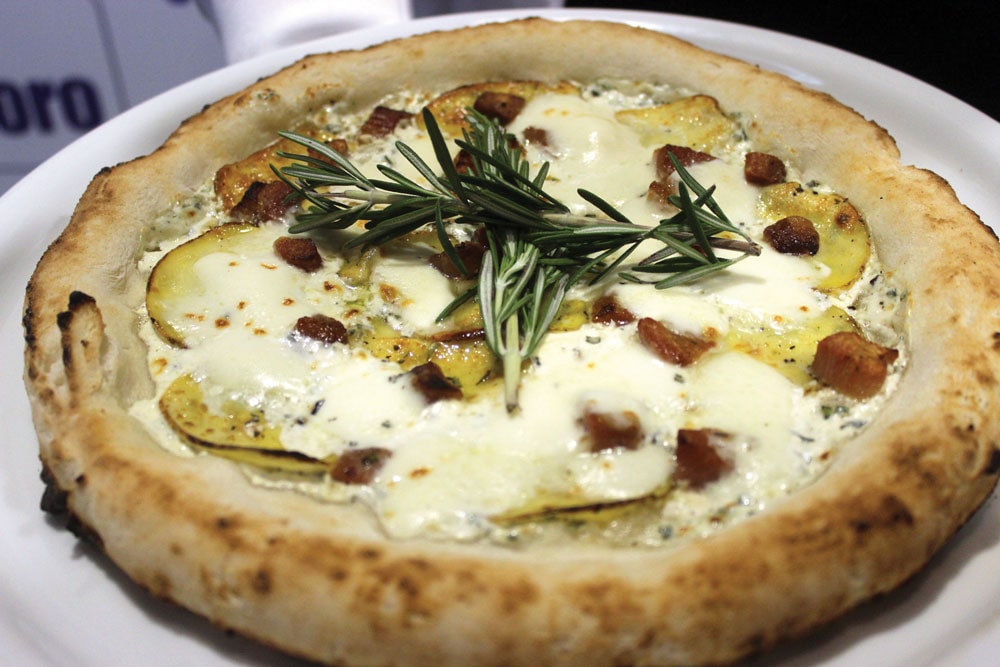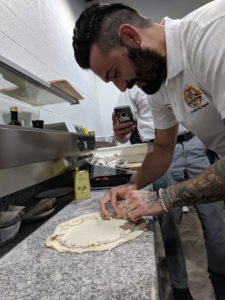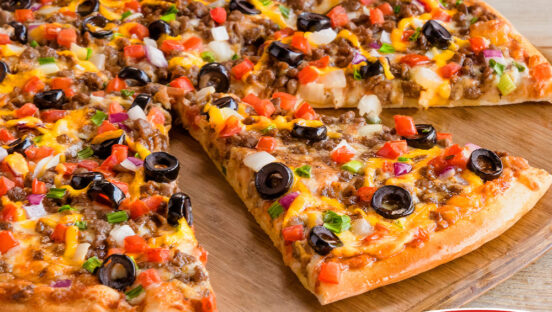Wood-fired pizza is a fast-growing market in the U.S. pizza industry. As more Americans are discovering the bliss that is a perfectly cooked Neapolitan-style pizza—with its soft and airy crust, perfect leoparding on the cornicione and fresh ingredients—one group of people has been left behind: the gluten-free customer. U.S. Pizza Team member Gianni Gallucci, owner of Gallucci Pizzeria Napoletana in Chicago, decided to attack that problem head-on. In this interview, Gallucci shares his thoughts on why it’s important to offer a wood-fired gluten-free option.
Hernandez: You won first place in Classico and third place in Gluten-Free at the Midwest U.S. Pizza Cup in Chicago in 2018. Gluten-free has evolved from having the taste and texture of a yoga mat to something quite impressive. How do you make a wood-fired gluten-free Neapolitan-style pizza crust?
Gianni Gallucci: It starts with using the right flours and blends. For the most part, we treat our gluten-free pizza the same as a regular Neapolitan, with the same hydration and cooking temperature. We do cook it a little longer, about two minutes versus 75 to 90 seconds. We also add some fats to the dough, some olive oil and a little sugar. We’re not able to slap it out like the Neapolitan, since it doesn’t have that gluten structure to give it strength, but it handles well as a “patting down” dough. We are, of course, keeping everything safe from cross-contamination, wiping down counters and tools. But you really need to test your own blends with your own oven.
Hernandez: Are there some premade mixes available?
Gallucci: There are, and they are really good building blocks for this particular style of gluten-free pie. Most even have a recipe on the side of the bag, so any beginner can start testing and then dial in their own recipe. Again, it’s about the ease of use. You want to be able to do gluten-free in approximately the same amount of time as your regular-menu pizza. The mixes definitely help if you’re a beginner. I personally competed and won with Caputo’s Fiore Glut at the U.S. Pizza Cup.
Hernandez: How should someone introduce a gluten-free Neapolitan-style pizza in their restaurant?
Gallucci: When we first started, we did reservations only. We made maybe six to 10 gluten-free pizzas a week. We worked our way up to 450 a week. It’s a learning experience for you and your customers. If you can’t accommodate a party that has only one gluten-free customer, that party is going somewhere else. Once they know you offer it, though, they’ll start telling their friends as well, and from there it just snowballs.
Hernandez: How did your customer base react to the gluten-free Neapolitan style pizzas?
Gallucci: We would serve the pizza, and the customer would say, “No, I ordered a gluten-free pizza.” We would have to assure them, “This is a gluten-free pizza.” Some would even push back again and ask to speak to a manager, saying, “There is no way this is gluten-free.” That is the best compliment you can get.
Hernandez: Why do you think a Neapolitan-style pizzeria should offer a gluten-free pizza?
Gallucci: When you’re a wood-burning restaurant, that oven is the focal point of your place. It doesn’t make sense to have numerous types of ovens to create different types of pizzas. If you do wood-fired pizza, create a wood-fired gluten-free recipe so you can still give that one gluten-free customer at a table the same experience as the rest of their party. The customers remember that, and it translates well for you.
Hernandez: Does having one oven cause issues with your gluten-free customers?
Gallucci: In the years we’ve been doing this, and the thousands of pies we have made, we have never had a complaint about [anyone getting ill]. We obviously cannot be a 100% gluten-free establishment. The key is to let the customer know you’re gluten-friendly (rather than gluten-free). Put a disclaimer on your menu. Customers will understand. Now, they are here eating an actual pizza! The days of customers feeling bad or embarrassed about being gluten-free are long gone. Just make sure to keep a small section of the oven available solely for the gluten-free pies. And always, always keep your gluten-free station, ingredients and tools separate from the rest of your kitchen production.
Hernandez: What are your best tips for working with gluten-free in a high-heat oven?
Gallucci: At the beginning, be patient with the oven. If you touch that pizza too soon, there is nothing holding it together. Also, be more careful and patient with stretching, as you would with most gluten-free doughs. Once you learn the dough and the motions, you’ll pick up speed.
“[Premade mixes] are really good building blocks for this style of gluten-free pie. Most even have a recipe on the side of the bag, so any beginner can start testing and then dial in their own recipe.”
— Gianni Gallucci, Gallucci Pizzeria Napoletana
Hernandez: With patience in mind, what’s the average make time for someone at Gallucci making a gluten-free pie?
Gallucci: I could probably make a gluten-free Margherita in about a minute, minus the cook time—three to 3.5 minutes out of the oven. Most of your extra time with a gluten-free wood-fired pie comes from the stretching and cook time. But the speed will come eventually. You can’t change how long it takes to do it right. It’s worth it in the end, and your customers will notice.
Hernandez: What inspired your gluten-free recipe?
Gallucci: It was when we started getting the samples from flour companies. I remember it was raining, a little slow at the time. I saw the bag sitting there and started playing around with it. Once I saw what its potential was, the pizzaiolo in me couldn’t stop refining it. There was a demand for it in 2018, and there still is today. It’s another revenue stream that can be done well without a lot of extra steps, if done correctly. It worked out well for my customers and the restaurant.
Hernandez: Are there many wood-fired pizzerias that offer gluten-free Neapolitan-style pizza out there?
Gallucci: Not that I know of, but even if there are, there probably aren’t many in your town. It’s worth it to set yourself apart from the crowd. We’re in downtown Chicago, and we have customers driving from Wisconsin for these pies. Fresh is best. With the exception of gluten-free-only establishments, people tend to buy premade, par-baked disks. Nothing beats a fresh, right-out-of-the-dough-box crust, baked at 850° in a wood-fired oven.
For an extended interview with Gianni Gallucci, visit PMQ.com/gallucci.















